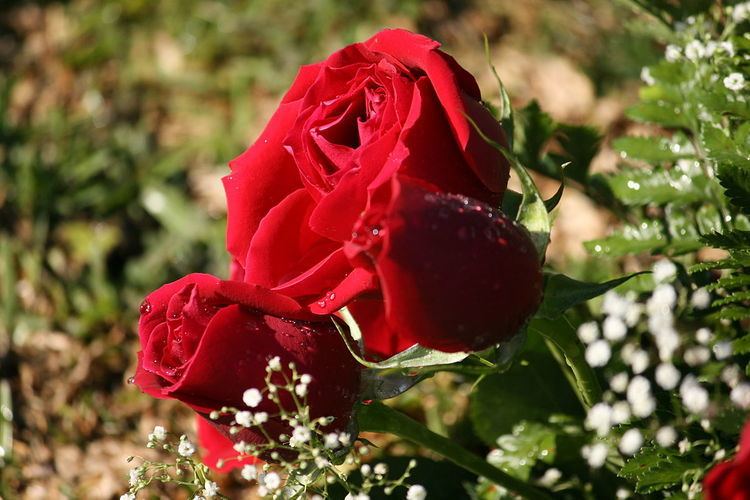 | ||
The rose has long been used as symbols. "Rose" means pink or red in a variety of languages (such as the Romance languages and Greek).
Contents
Christianity
The rose was an icon of veneration in the pre-Christian era, and was used in ancient Rome to symbolize devotion to the goddess Venus. Following the Christianization of Rome under the emperor Constantine, the rose became identified with the Virgin Mary. The rose symbol eventually led to the creation of the rosary and other devotional prayers in Christianity.
Islam and Sufism
The cultivation of geometrical gardens, in which the rose has often held pride of place, has a long history in Iran and surrounding lands. In the lyric ghazal, it is the beauty of the rose that provokes the longing song of the nightingale - an image prominent, for example, in the poems of Hafez.
In turn, the imagery of lover and beloved became a type of the Sufi mystic's quest for divine love, so that Ibn Arabi, for example, aligns the rose with the beloved's blushing cheek on the one hand and, on the other, with the divine names and attributes.
Other well-known examples of rose symbolism in Sufism include;
Catalonia
Catalonians have traditionally celebrated Saint George's Day (April 23)—which commemorates Saint George (Sant Jordi), the patron saint of Catalonia—as the dia dels enamorats (lovers' day), on which lovers exchange blood-red roses.
England
The rose is the national flower of England, a usage dating back to the English civil wars of the fifteenth century (later called Wars of the Roses), in which a red rose represented the House of Lancaster, and a white rose represented the House of York. The Tudor dynasty created the Tudor rose, which united both the white and the red roses, a symbolism dramatized by Shakespeare in his play Richard III. The traditional ballad "The Rose of England" (Child 166) recounts the seizure of the crown by Earl of Richmond (who became Henry VII of England, the founder the Tudor dynasty), using the "red rose" as an allegory for Henry.
The England national rugby union team and Rugby Football Union adopted the red rose as their symbol in 1871, and the rose has appeared on players' kit ever since.
United States
In 1986, the rose was adopted as the national floral emblem of the United States.
It is the state flower of four U.S. states:
Portland, Oregon has counted "City of Roses" among its nicknames (see roses in Portland, Oregon) since 1888, and has held an annual Rose Festival since 1905. The city is also known for its International Rose Test Garden.
Pasadena, California—also nicknamed the "City of Roses"—has held the annual Tournament of Roses Parade since 1890, and 1902 the Parade has been held in conjunction with the Rose Bowl Game (which is now played at the city's Rose Bowl stadium, built in 1922).
In April 2011, the U.S. government's space program agency, the National Aeronautics and Space Administration (NASA), celebrated the Hubble Space Telescope's 21st anniversary by releasing an image of spiral galaxies Arp 273 positioned in a rose-like shape.
The red rose is also the official symbol for the Democratic Socialists of America (DSA).
Canada
In 1930, Rosa acicularis (the wild rose or prickly rose) was adopted as the official provincial flower of the Canadian province of Alberta. The suggestion that a provincial floral emblem be adopted by first made by an Edmonton newspaper editor; "the Women's Institutes took up the suggestion and passed it on to the Department of Education, and the province's schoolchildren made the final choice."
The Wildrose Party, a now-defunct Albertan political party, was named after the province's official flower.
Mexico
The Mexican city of Guadalajara, the capital of Jalisco, is nicknamed the "City of Roses" (Ciudad de las Rosas).
Socialism and social democracy
The Tamiment Library and Robert F. Wagner Archives at New York University states that the rose "has always been an important symbol with anti-authoritarian associations." The rose symbol became popular among socialist and social democratic political parties in post-World War II Europe. The symbol of a rose in a fist is used by the Socialist International "and many of its member parties" such as the French Socialist Party (PS).
The British Labour Party has used a red rose as its symbol since the late 1980s; the rose replaced the party's previous symbol, the red flag.
Other
The White Rose was a World War II non violent resistance group in Germany.
